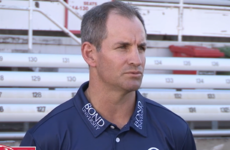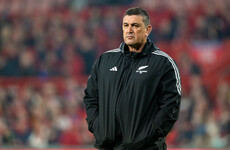TG4 will broadcast the 2016 Pro12 final on Rugbai Gold, this evening at 19.15
CELEBRATION IS A difficult, downright counter-intuitive, theme to build around a group approaching the climax of the season and their first experience of a major final.
Although the word itself is rooted in carefree fun, sport over the years has conditioned players and onlookers to associate the pinnacle of it with mounting tension. Rugby lends itself more easily than most games to the language of war. Bodies are on the line for the cause, blood is spilled and intensity is heightened for do or die moments.
After battling and grinding through two narrow wins over Glasgow Warriors – and, a few weeks before, scraping a 7-6 win over Leinster – Connacht approached the 2016 Pro12 final with a remarkable swagger.
They were fluid, confident, loose and a joy to watch. Completely at odds with how we imagine any team, let alone a first-timer, shaping up for a final.
“We said the goal was top six, that we’re going to get ourselves into the Champions Cup. We reset those goals,” said Pat Lam the day before the Murrayfield decider against Leinster.
“This weekend is a celebration for what we have done as a group.”
That ‘group’ was a sizeable one. Connacht went to Scotland not just with a matchday 23 and reserves, but with the full contingent of senior and academy players. This was an occasion to invite the whole family along to, a coming together to underline the years of effort and energy that was ploughed into Connacht’s rejuvenation under Lam. To maintain the sense of identity and style that was so hard won for this team.
The exhilarating pace and freedom with which Connacht attacked throughout that season and in particularly in the final was an astounding badge of honour that made the trophy all the more meaningful.
“You get to a point where your tighthead stands in as scrum-half three times in a final,” says John Muldoon after a few months to absorb the experience in full.
“That might go unnoticed by a lot of people, but when your tighthead can fling a pass, left-to-right, 10-12 metres and you’re not relying on your number nine to get there it makes a huge difference.”
The western province didn’t freeze in the final because their ethos was built around playing a certain way. Doing, rather than thinking and worrying whether execution would be perfect or not.
With a trophy on the board, Lam could afford a wry smile when looking back on calls from the crowd in the Sportsground to kick the ball, to play sensible wet-weather rugby or simply clear lines and deal with later danger. The Samoan took convention and turned it upside down, shaping Connacht like a Super Rugby side on hard ground.
“When Pat came in and said: ‘this is Galway, we don’t care what the weather’s like, this is the way we’re going to play’ it certainly got a few raised eyebrows, but it’s done well for us,” added Muldoon.
It was wholly fitting that Connacht’s try-scorers in the thrilling 20-10 win were their starting back three, but the hallmarks of the style were the ball-playing skills of their forwards. If Finlay Bealham could smoothly slot in as a false 9, the false 10 was second row Aly Muldowney.
The lock passed the ball a whopping 19 times against Leinster in Murrayfield, more than the combined tally of the opposition’s starting pack.
“We talked about it like: ‘well, we’ve come this far, there’s no point going into our shells. If we’re going to lose, we’ll lose. If we win, we’ll win. But we’ll do it our way, the way we like to play,’” Muldowney told The42 late in 2016.
“All year we’ve watched games back on TV and everyone’s going: ‘ah they should kick more, they shouldn’t play so much.’ And we’re like: ‘why? It’s working for us!’”
There is a slight risk of over-romanticising the winning side from that May day, casting them as happy-go-lucky, free-running, plucky and naive have-a-goers. We’ve touched on the hard-built template that Lam built for his side to play in, but there was no shortage of steel throughout the side either. Mental and physical.
Muldoon typifies that resolute refusal to live down to expectations set by the bookmakers and the full tale of Connacht’s struggles is writ large on his face through every frame of film that captured the celebration.
Ultan Dillane’s impact, in a very literal sense, came as an enormous fillip to his side. His merciless mowing down of the Kearney brothers served to give his team and the supporters in the stand a foothold of belief that helped them cling on and defend their lead through to the finish.
For Leinster, the match turned out to be a turning point of sorts. It was the end of Leo Cullen’s first season as a head coach and thereafter, he complemented his skills with coaches who could boast vast experience. Later that summer, Graham Henry came in on a consultancy basis. And when a family bereavement prompted Kurt McQuilkin to depart, Stuart Lancaster was the next man into the coaching box.
For Connacht, there were fewer new beginnings. But many glorious ends.Muldowney set off for France, backs coach Andre Bell returned to New Zealand, Robbie Henshaw crossed the Shannon and AJ MacGinty’s US caps nudged him on to Sale. Lam, Muldoon and unheralded stalwarts like Andrew Browne would move on in the following years too.
That sense of finishing off a stint can often easily lend itself to easing off the pedal and lead a team to unravel. But throughout the whole gripping affair, there were any number of moments when a lesser team, an underdog with fewer teeth could have cursed their luck and accepted a turning of the tide. The curious tale of John Cooney’s final takes pride of place in that category.
Long before Cooney made himself the most influential player in European rugby – as he has been this season – he played back-up to Kieran Marmion. When his opportunity arrived, his luck buckled almost instantly as he suffered a dislocated shoulder and had to trudge back across the sideline for the second time in just four minutes.
Matt Healy stood in as a makeshift scrum-half and the experiment almost went awry instantly with a pass that left MacGinty reaching high above his head before he could clear his lines.
But ‘almosts’ weren’t going to cut down Connacht on an occasion like that. They were 100% devout followers of Lam’s gameplan and structure and they left Leinster no room to turn an improved second half into a comeback win to snatch the trophy.
The champagne and tears flowed in the dressing room and as the team’s flight touched down in knock there were bonfires lit lest the bus required beacons to safely get back to Galway.
And on Shop Street, when some celebrations were just fizzling out with the clock turning 2am, Connacht Rugby’s still had a few more gears to reach for.
















It wrecks my head that Stephen Ireland scored the first goal for Ireland in Croker. I couldn’t think of a player worse than him to score it.
@Ned Flanders: Roy Keane would be a good candidate for you.
18/20, not too bad, definitely guessed a couple.